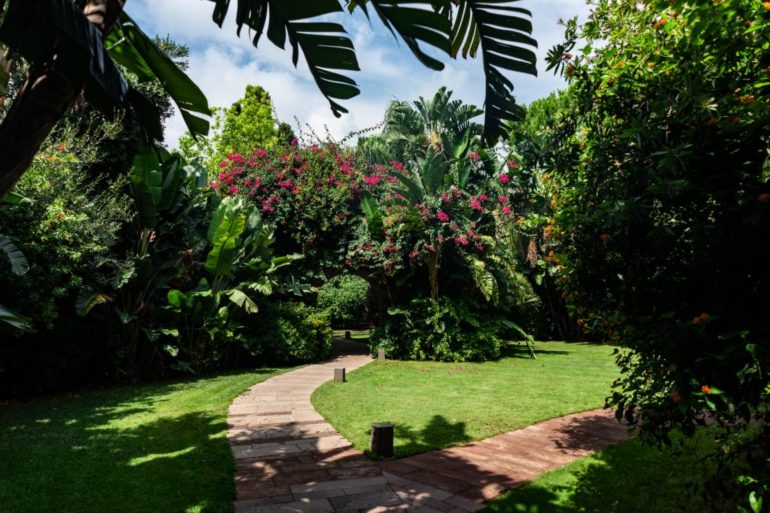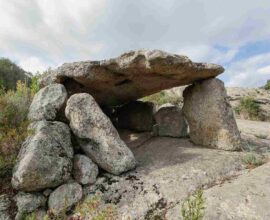Tropical Garden: the 10 most beautiful exotic plants in Sardinia
Tropical Garden: 10 beautiful exotic plants of Sardinia
“In the middle of the grass, under the trees, in the grey vases of the niches, one could see white, golden and purple brushstrokes; above his head the trees were pink and white, and everywhere you could hear beating wings, fluttering sounds, buzzing, the scent of sweet perfumes”, if the description of this landscape did not belong to the famous children’s novel, The Secret Garden, by the Anglo-American writer Frances Hodgson Burnett, it would be easy to imagine Sardinia a tropical garden illuminated by the sun, perhaps just a short walk away from the incredible crystal clear sea.
The island, in the heart of the Mediterranean Sea, is home to some exotic species that represent an integral part of the Sardinian territory, an ideal place for an adventurous vacation to explore the unspoiled nature, embraced by the winds that dominate the land called Icnussa by the ancient Greeks.
Among the rugged coasts that embrace the beaches in pink shades and the soft waved-shaped hills, beautiful plants hide, fragrant and with lush foliage, arriving from distant lands as a result of numerous journeys that men have made over the centuries
A green open-air paradise that the Mediterranean climate contributes to make unique, where endemic species are coupled with plants from Africa, Asia and some parts of South America.
A tropical garden can also be made to measure, depending on the available space, to create a green space in which to enjoy relaxing moments and focus on our well-being, surrounded by plants and flowers that give an original touch to the appearance of your outdoor environment.
Let’s discover the ten most beautiful exotic plants for a dreamy tropical garden.
Tropical Garden: 10 beautiful exotic plants that you can find on the island of Sardinia
Whether it is a wild tropical garden or a small green area with an exotic taste, allow yourself to be captivated by the beauty and the scent of flowers and trees from distant countries.
These ten exotic plants, present in the Sardinian territory, make a place on Earth similar to the Eden.
-
Agave: widespread throughout the world, it is found mainly in public and private gardens. It is a kind of monocotyledonous succulent plant, whose name was given by the Swedish physician, botanist, naturalist and academic Carll Nilsson Linnaeus known by the Italian name of Carlo Linneo. Coming from the Caribbean islands, the Agave can also be found in the southern areas of North America and in the northern areas of Central America, but the greatest concentration of varieties are found in Mexico.
-
Carpobrotus: the name, of Greek origin, derives from the words karpos (fruit) and brotos (edule), but in Italy it is known as “witch’s nail”. Carpobrotus is a plant belonging to the Aizoaceae family and has a vigorous flourishing characterized by large yellow, purple and white edible flowers. It is particularly common in the desert areas of South Africa, but some species are also present in South and North America and in Australia.
-
Opuntia ficus-indica: Simply known as prickly pear, it is a succulent plant of the cactaceae family and belongs to the genus opuntia. It is native to Mexico, but it can also be found in South America and in some areas of Asia, Oceania, Africa and America. The plant arrived on the European coasts, and more precisely in Lisbon, thanks to Christopher Columbus and was already known by the Aztecs who considered it sacred. The prickly pear can reach up to 5 meters in height, has cup-shaped flowers with shades ranging from yellow to orange and edible fruits of different colors: yellow-orange, purple red and white.
-
Eichhornia crassipes: known as the water hyacinth is a floating aquatic plant that is found on the surface of rivers and lakes of tropical regions, and is native to the Amazon basin. The flowers, grouped in a sort of ear, have a blue-violet color with small yellow spots on the upper petals while the leaves, whose petioles allow the plant to float, are rounded and green.
-
Oxalis pes-caprae: native to South Africa, the yellow acetosella is a perennial herbaceous plant belonging to the family of Oxalidaceae that arrived on the island of Malta in 1806, thanks to an English lady, coming from the City of the Cape, that donated it to a local botanist. It is also known as the yellow clover because of the shape of the trefoil leaves that resemble those of a clover, while the flowers, of the same color from which the plant takes its name, have a corolla formed by five petals.
-
Plumeria: belonging to the Apocinacee family, it is a plant native to tropical America. The leaves are large, oblong and pointed with a beautiful green color whose intensity varies according to the species. The flowers, on the other hand, are very reminiscent of the oleander and are large, fragrant, gathered in terminal buds of white, cream, red and yellow colours, paler towards the center.
-
Ficus lyrata: native to Africa, it is an evergreen plant belonging to the Moraceae family and the genus Ficus. It has lush foliage, shiny and dark green with a wavy edge and yellow or white veins, characteristics that make it a perfect ornamental plant. It was the German botanist Otto Warburg who chose the name of the species and was probably inspired by the particular shape of the leaves that resemble musical instruments such as the lyre and the violin.
-
Pyracantha coccinea: also called agazzino, it is an evergreen plant native to Asia Minor and also widespread in Europe. Belonging to the Rosaceae family, it has a rounded crown and long thorns that make it the ideal plant to create thick and inaccessible hedges. It was known by the Greeks “thorn of fire” by the union of the words “pyra”, fire, and “akanta”, thorn.
-
Colletia cruciata: the main characteristic of the plant is the shape of the leaves, rigid and pointed, which resemble the wings of many small airplanes in the air. Native to South America, in the flowering period, the collection is covered with tiny and beautiful white tubular flowers with a characteristic scent of vanilla butter.
-
Ficus carica: also known as the common fig, Ficus carica is a fruit tree belonging to the family of the Moraceae and the genus Ficus and produces the famous fruits called figs, fioroni and cimaruoli. The name refers to Caria, a region of Asia Minor, and testimonies of the cultivation of Ficus carica date back to the first agricultural civilizations of Mesopotamia, Egypt, and Palestine. For the ancient Greeks the fig tree was an aphrodisiac fruit and according to Plato, consuming them in large quantities can reinforce intelligence. The Romans instead used to eat them as an appetizer, adding some salt and vinegar.






